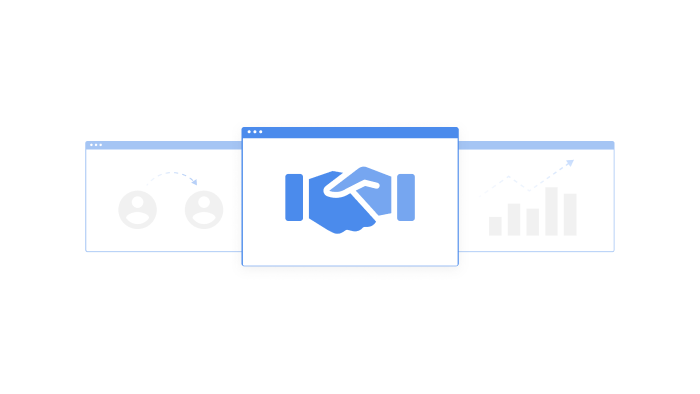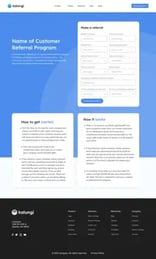How to measure the ROI and impact of your B2B SaaS content marketing
The first step towards impactful content marketing that drives an ROI is delivering the right value to the right people at the right time.

In B2B SaaS, there are marketing efforts that scale, but take longer to ramp up, and some that provide quick wins. Quick growth efforts are typically prioritized at an early stage but eventually hit a ceiling. There are only so many clicks you can buy, so many contacts you can scrape, and so many calls you can make.
Successful companies find a way to build repeatable and scalable programs like content marketing, SEO, social marketing, and referral programs. This article will give you a detailed framework and tools to get your referral campaign off the ground. You'll also find examples of successful models for your referral program.

Fill out the form below and we’ll send you a template with an easy-to-use google document that walks you through how to create your own B2B SaaS referral program.
Building a successful customer referral program does not require over-complicated strategic planning. All you need is a roadmap to what success looks like for your B2B SaaS venture. Here is a simple guideline:
Execution is important but strategic planning is key. You cannot build a referral program if you have not yet reached Product Market Fit (PMF). It would be a waste of your time and resources because customers won’t refer your solutions unless they truly love it. Obvious and yet essential. A successful launch has everything to do with timing and coordination. Before you do anything else about your referral program, ensure that you collected enough data from your customer. Let them tell you about your strengths and weaknesses.
You are operating in the B2B world, which means you have to create a double incentive. One for your referees and one for their company. A single individual will not share their network with you if they do not personally benefit from doing so. Know your industry, know your customers and reward them with a gift they like. It can be an amazon gift card but it can also be more specific to your customers' habits. Yeti mugs would make any coffee drinker happy, but you should always make it specific to what that person does on a daily basis.
Don’t opt for the tradeshow giveaways route unless you know they like it. You may want to differentiate and offer a gadget everyone in your industry wants. It’s your call, do what you think it’s best. Here is a list of the most common incentives:
Once you determine your referees' incentive, choose how much they will save their company with their referral. Regardless of your pricing strategy, you can offer a per-user/device/feature discount. For example: “Get $X off your next annual SaaS bill (up to 100% off) for each seat the client you referred gets.”
This offering provides a strong incentive for your current customers and can bring exponential revenue growth if well calculated.
You must know your numbers before making an offer. A successful B2B SaaS referral program depends on your ability to find the middle ground between an attractive offer that also does help you generate revenue. Know your Customer Lifetime Value (LTV), know your Customer Acquisition Cost (CAC), know your Annual Contract Value (ACV) and run a few scenarios to see if your offer makes sense. At Kalungi, we determined that if you want to support a T2D3 growth, your LTV to CAC ratio should not be lower than 1 to 4. Here is how it’s calculated:
Marketing-led solutions usually have higher LTVs and can offer higher financial incentives. The opposite is true for product-led growth. For a deep dive into LTV to CAC ratio, check out this article or Geckoboard.
You want to make the whole referral process seamless. Remember, as much as your customers might love your product, they also have little time to spare. Make your landing page as straightforward as possible so your customers know exactly what they get out of it. Make it simple for them to add the contact information of their referral, and make sure you set up all the automation processes correctly to track who recommends who and when.
The last thing you want is customers coming back at you saying they recommended someone who turned into a client and haven’t received their gift. You also want to follow up with these new leads and coordinate your marketing efforts with your sales team.
Last but not least, timing is critical. Allow customers to refer others, especially when they just purchased and are excited about it. While implementation of a referral program is not extraordinarily complex, coordination between marketing, sales, product, and customer service teams is crucial.
Get everyone on board with the project, launch, and maintain the spark alive. This is a long-term marketing campaign which means that you will have to make adjustments. Treat it as a living project and do not let it die.
Now that you have a guide on how to build your referral program, check out how other B2B SaaS ventures do it.
You know your industry better than anyone so I am sure that by now you already have some great ideas about how to implement your referral program. Still, you should take a look at these examples. Inspiration from great work never hurts anyone.
In B2B Saas, you must regulate who recommends you. It’s quality versus quantity. It does not mean you cannot scale your efforts. Take HubSpot, for example. They know every client is looking for the “reduce my bill” button. To tackle that part of the market, they created a Solutions Partner Program. This is specifically for agencies that use HubSpot themselves and are so confident in the solution that they recommend it to their clients.
The incentives for this referral program have a significant $ amount associated with it. If you visit the webpage, you’ll notice a filter in place. To benefit from this referral program, partners must pay a monthly fee. This is how HubSpot filters its referees. The entree fee is high enough that only serious contenders would be willing to participate in the program.
HubSpot also knows that content marketing is crucial to its growth. Therefore they created an affiliate program to compensate the creators that promote HubSpot with valuable content creation. There is a catch too. Not everyone is eligible to join the program. Individuals must apply and go through a review process before they become eligible to earn commissions.
For both programs, the landing pages are relatively easy to follow, the offer is straightforward, and you’ll notice they target two different audiences. It hits all the to-dos listed above.
Here is another great example of a B2B Saas referral program. Similar to HubSpot, you’ll find two referral programs. An enterprise-level where current customers can become partners and an affiliate program to support the product-led growth strategy of the company. In the first plan, partners must become certified before they can earn commissions. On the second plan, individual users can get a referral link and share it with their colleagues, friends, and family for a discount on their current subscription.
Some companies keep it secret. Or at least to the public. This is a great strategy to keep noisy promoters out of the game and allow only the right people to advocate for your solution. At Kalungi, we recommend starting with such a strategy. You’ll have more control over who has access to your referral program.
In fact, a great way to collect information before you start ungate your program is asking every new customer how they heard about you. This can be as simple as checking a box during the onboarding process. Use the data collected to spot the channels that perform best and find the super promoters. Only then should you cast a wider net of promoters.
This is a great example of easy referrals. Project management tools are efficient only if your co-workers, colleagues, and friends use the platform. With Trello, anyone who adds a new user to their board is eligible for a specific discount on their subscription. The key here is that the program offers a discount of up to 100% off per month.
On the one hand, this creates a great incentive for current customers since they can use the tool for free. On the other hand, it encourages customers to promote the app and yet limits the reward to 12 referrals per year. Promoters will likely continue to add people on the board, making the referral program very successful. This is also a great illustration of product-led growth strategies.
There are some third-party tools you can utilize too. For example, the Capterra model is a great way to utilize the hard work you put in preparations for your referral program. As mentioned before, online reviews are a great way to create trust in your solution. Additionally, Software Advice will let you pay for each recommendation their advisors make. This is a great way to utilize a trusted organization to promote your SaaS. Advisors will assess buyers' needs for free and only recommend products that meet buyers' needs. You can get great leads out of such marketing efforts too.
Measuring your content marketing efforts is crucial in B2B SaaS, and you can utilize tools like Sparkloop or Viral Loops to encourage current readers to share your content. This type of marketing strategy can be highly beneficial in the long run since your content will be shared broadly by your current reader. It’s a great way to position yourself as a thought leader in your industry and will help you attract top-of-the-funnel leads. Using these third-party tools to encourage newsletter referrals will help you reach a broader audience with very low friction and engage your current customers.
It is not easy for B2B SaaS business to go viral; it’s just the nature of the space. This means you are responsible for creating the medium through which customers can put in a good word for you. Start building your B2B SaaS referral program to drive revenue for your company while reducing your CAC.
Antoine is a strategic marketing leader with a Master’s in International Business from NYU. He has worked with 20+ SaaS companies across different industries to reach their full growth potential.
The first step towards impactful content marketing that drives an ROI is delivering the right value to the right people at the right time.
Add value and deliver the right message to the right people at the right time with targeted content for your B2B nurture campaigns.
Promoting your content is important to provide value for your intended audiences. And for B2B SaaS companies, LinkedIn and Facebook are the two most...
Be the first to know about new B2B SaaS Marketing insights to build or refine your marketing function with the tools and knowledge of today’s industry.